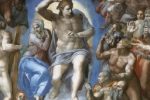Was Jesus Born on Christmas Day?

My wife and I took the kids Christmas light watching last night, December 26. We are always saddened to see so many folks already taking down their lights or leaving them off only one day into the Christmas Season! For the world—and unfortunately many Christians—Christmas is over because Christmas Day has passed. For Catholics, Christmas has just begun because the Christmas season stretches from the vigil of Christmas, on the evening of December 24, until the Saturday after the Feast of the Epiphany. This year that will be January 11th.
It is so fun to be Catholic! Catholics know how to party… or perhaps more accurately… feast! And this is not to mention the fact that I get to keep my Christmas lights up longer… and with the meaning behind it to boot!
With this in mind I thought I would do a Christmassy blog post and answer one of the most common questions I get each year during Advent and Christmas: “Was Jesus really born on December 25?” Many will claim Christians stole the date of a pagan feast honoring “the unconquered sun god” (Sol Invictus), or some other god, and inserted Christ in its place. Others will say Jesus could not have been born during winter because St. Luke’s Gospel provides:
And in that region there were shepherds out in the field, keeping watch over their flock by night…
It would be “too cold,” the pundits say, for shepherds to keep watch over these flocks at night, if it were late December. It had to be spring, summer, or perhaps early fall, no?
Many others of a “sola scriptura” bent will claim the text of Scripture is silent on the matter so we really don’t know when Christ was born. Any attempt to ascertain the truth of the matter would be purely conjecture and unimportant.
So what gives?
Is Christmas Pagan at its Core?
As my colleague at Catholic Answers, Jon Sorenson, pointed out (among other things) in his blog post of December 16, 2013, there is a very large reason why we can be certain Christmas on December 25 is not a case of Christian thievery: There is no known record of a pagan deity whose feast day landed on December 25 before the advent of Christ. In other words, there was nothing there to steal.
Three popular attempts at “proofs” of pagan feasts from which Christians would have “borrowed,” fail decidedly. First, the claim that “Saturnalia,” or the feast dedicated to the Roman god Saturn, established ca. 220 B.C., was pilfered fails for the simple reason it was originally celebrated on December 17, and later extended to an entire week, ending on December 23. It was not celebrated on December 25th. If you wanted to take over a feast day, you would either want to preempt the feast’s date, or more likely, you would want to use the actual date or series of days in order to supplant it.
The more common attempt to say Christians stole a pagan feast day for their celebration of Christmas centers on the pagan feast of “Natalis Sol Invictus,” (the Birth of the Unconquered Sun). This feast is implied as being celebrated on December 25 by St. Cyprian of Carthage (more likely Pseudo-Cyprian), in De Paschae Computus, XIX, written in AD 243:
O, how wonderfully acted Providence that on that day on which the Sun was born… Christ should be born.
In its article titled, “Christmas,” the 1913 Catholic Encyclopedia records St. John Chrysostom as writing ca. a hundred years later:
But Our Lord, too, is born in the month of December… the eighth before the calends of January [25 December]… But they call it “the Birthday of the Unconquered.” But who indeed is so unconquered as our Lord… ? Or, if they say that it is the birthday of the Sun, He is the Sun of Justice” (referencing a prophecy concerning Christ from Malachi 4:2).
The worship of “the Unconquered Son” would reach its pinnacle in AD 274 when as a reform measure the Roman Emperor Aurelian would reinvigorate the worship of “Sol” on December 25 in order to unify the empire both morally and religiously.
The real question; however, is when the date of December 25 was adopted as the central feast day for “Natalis Sol Invictus.” The assumption that Christians took the date of Christmas from these pagans is highly unlikely for two key reasons. First, this pagan feast was, like Saturnalia before it, tethered to the winter solstice. December 25 is always after the solstice. That would be an odd date to choose.
Second, there is no record before St. Cyprian, or Pseudo-Cyprian, in AD 243 that this feast was ever actually celebrated on December 25 at all. The evidence, in fact, would seem to indicate that it was the pagans who moved this feast to December 25 in order to combat a rapidly growing Christian faith in the Roman Empire that had become radically hostile to it. More on this below:
And finally, there is the “Mithraist” connection. Many claim it was a feast dedicated to the god “Mithras” that Christians absconded. But this argument fails as well. While there is historical evidence that links the worship of Mithras and Sol Invictus (inscriptions on ancient votive candles and ancient works of art), as Sorenson says, “In some cases it appears Mithraists believed that Mithras and Sol were two different manifestations of the same god,” or even, “two gods united as one,” the claim Christians stole a feast dedicated to this god is more easily and readily dismissed.
The problem here is that when Emperor Aurelius reinvigorated the feast of “the Unconquered Sun” in AD 274, there was nary a mention of Mithras at all. It appears the joining of “Sol” and “Mithras” would come sometime later. The connection of Mithras to December 25 would be due to his connection to Sol and would then be moot in considering which came first, the Christian date for the birth of Christ or the pagan feast.
But It’s Cold Outside!
Only a mind tainted by modern convenience would come up with this second argument against a late December birth of our Lord. It would have been “too cold outside” to have sheep or shepherds “out in the fields… by night?”
Really?
In Genesis 31:38-40, Jacob recounts to Laban how he has labored 20 years in order, ultimately, to gain Laban’s beautiful daughter, Rachel:
Have I therefore been with thee twenty years? thy ewes and goats were not barren, the rams of thy flocks I did not eat: Neither did I shew thee that which the beast had torn, I made good all the damage: whatsoever was lost by theft, thou didst exact it of me: Day and night was I parched with heat, and with frost, and sleep departed from my eyes (Douay-Rheims Version).
Notice, Jacob does not say, “When the first frost came, I hurriedly got your sheep indoors as fast as I could.” Why would this be? Well, anyone raising sheep knows you keep them in the fields as long as possible because it is more cost-effective to leave them in the fields to eat free grass and drink from available water sources verses bringing them indoors where you have to hire folks to gather a whole lot of food and water for them to survive and thrive.
Further, Bethlehem is found at 31.7031 degrees North latitude and 35.1956 degrees longitude, which makes it comparable to Alexandria, La., or Albany, Georgia. It has a moderate climate where December is part of the rainy season. December would then be among the very best times of the year to have sheep in the field. There would have been much greenery for them to consume. And rest assured, even though the average temperatures “by night” would have probably been in the 40’s farenheit, an early frost would not send these shepherds scurrying for the comforts of home. If you want to feed your family, you keep the sheep in the fields during the day and you “keep watch over them by night.”
Positive Evidence Christ was Born on December 25
Writing in ca. AD 200, St. Hippolytus gives us an ancient example—over four decades before any mention of a pagan deity being worshipped on December 25—of Christian belief that Christ was born on December 25th:
For the first advent of our Lord in the flesh, when he was born in Bethlehem, was December 25th, Wednesday, while Augustus was in his forty-second year, but from Adam, five thousand and five hundred years. He suffered in the thirty-third year, March 25th, Friday, the eighteenth year of Tiberius Caesar, while Rufus and Roubellion were Consuls (Commentary on Daniel, Bk. 4, Ch. 23).
The reference to Adam here is crucial, because in another work titled Chronicon, he argues that Christ was born nine months after the anniversary of the Creation. According to St. Hippolytus, the world was created on March 25, the vernal equinox. Jesus, the beginning of the new creation, would have then fittingly been conceived on March 25 and then born nine months later, on December 25.
In his now classic, Spirit of the Liturgy, Pope Benedict XVI uses these historical facts as key to understanding the December 25 date for Christmas:
The claim used to be made that December 25 developed in the opposition to the Mithras myth, or as a Christian response to the cult of the unconquered sun promoted by Roman emperors in the third century in their efforts to establish a new imperial religion. However, these old theories can no longer be sustained. The decisive factor was the connection of creation and Cross, of creation and Christ’s conception (p. 105-107).
The key here is not whether the earth is young or old. It is not even whether St. Hippolyus’s reasoning was correct (and the others I will mention below). The significance here is to note the Christian apology for December 25 had nothing to do with a pagan feast. There is simply zero evidence of any Christian saying, “Let’s take over this pagan feast day!” And more importantly, this apology was given before there is any record of a pagan feast to have been celebrated on December 25 at all.
In a nutshell, what we have in Christian history is an historical fact that Christ was born on December 25, followed by Christian apologists bringing out the deeper meaning behind the historical date.
But What of the Claim That There Were Differing Dates?
It is well-documented that while the West celebrated Christmas from the earliest days of the Christian era on December 25, in some areas in the East especially, it was January 6 (and a few other dates as well). Why the confusion?
It is not clear why January 6 became the date to celebrate Christmas in some Eastern churches. Most likely, it is a later development where the birth of the Lord, the epiphany, and in some areas the baptism of the Lord as well, were contracted into one great feast day. But it is clear that December 25 is the more ancient date and the one that would eventually win the day throughout the world. Only the Armenians today continue to hold to the Jan. 6 date.
Consider these historical facts:
1. St. Theophilus (A.D. 115-181), Catholic bishop of Caesarea in Palestine wrote: “We ought to celebrate the birthday of Our Lord on what day soever the 25th of December shall happen” (Cited in: Dr. Taylor Marshall, God’s Birthday: Why Christ Was Born on Dec. 25 and Why It Matters).
2. We’ve already seen St. Hippolytus do the same in ca. AD 200.
3. Julius Africanus repeats this in AD 221, in his Chronographai.
4. By the fourth century, there is little doubt in the Christian world as to when Christ was born. St. Gregory of Nyssa, St. Augustine and more would begin a symphonic proclamation. For these and other reasons, modern scholar, S.E. Hijmans, admits:
While they (the Christians) were aware that pagans called this day the “birthday of Sol Invictus,” this did not concern them and it did not play any role in their choice of date for Christmas (Hijmans, S.E., Sol, the Sun in the Art and Religions of Rome, p. 595).
To Sum It Up
Perhaps St. John Chrysostom, the powerful fourth-century Patriarch of Constantinople, in a sermon he preached in Antioch wherein he urges the church in the East to adopt the Roman practice of celebrating December 25 as the date for the Feast of the Nativity of Our Lord, sums up best the historical truth of the matter. And, by the way, he was successful in reforming the date of the celebration in the East. While there were objectors to this practice (and we should note here that this is a practice, not doctrinal), his arguments are telling:
1. He argues that this practice is based on history as known from the time of the historical events.
2. The rapid diffusion of this custom proved its genuineness via the “sensus fidelium,” i.e., the “sense of the faithful” that will not steer the church awry.
3. He then goes to Scripture and shows how Zachariah, the Father of John the Baptist—as High Priest—entered the temple on the Day of Atonement (the Day of Atonement being in September) to perform his priestly functions. It was only then that he received the announcement of John’s conception, which would have made this joyous event fall in September.
Because Christ would have been conceived six months later (according to Luke 1:36, “this is the sixth month with [Elizabeth] that is called barren”), that would have been March. Nine months later comes December.
Problems with St. John’s line of reasoning: The text does not say it was “the Day of Atonement,” nor does it say Zachariah was the High Priest. Scripture reveals him to have been one of “the high-priestly family,” or one of “the chief priests,” “of the course of Abia” (cf. Luke 1:5), one of the twenty-four families stemming from the sons of Aaron who carried out the priestly functions throughout the year (see I Chronicles 24:10), including the “burning of incense” that we see Zechariah offering in Luke 1:9, a task given by God to Aaron in Exodus 30:7.
In defense of St. John Chrysostom, this does not mean it was not the Day of Atonement or that Zachariah was not one of the “High Priests” either. We know from Scripture that by the first century, there were multiple “chief priests” from the family of Aaron, or the “high-priestly family,” that could and would function as High Priest on a rotational basis (see Acts 4:6; John 11:49; Mark 8:31; Acts 4:23).
Interesting note: A nineteenth-century scholar, Friedlieb, in 1887, in a study on the life of Christ, actually traced back the priestly family line (each served a week in the temple at a time in succession) from the time of the destruction of the temple in AD 70. Jewish tradition (from Josephus) says the family of Jojarib was then serving. Assuming there was no break in the succession over those decades (some call that a bit of a stretch, but given the strong belief of the Jewish people surrounding the Temple and its administration, I don’t think it is that much of a stretch), Zechariah would indeed have been serving at the time of the Day of Atonement, Christ’s conception would have then occurred in March, and his birth, therefore, in December. Jewish history seems to fit like a glove.
We also have to take into account the fact that the Protoevangelium of James, written in ca. AD 140, records St. Zechariah as having been High Priest as does the ancient Eastern tradition. There is good historical evidence to consider here.
4. Finally, St. John appeals to the Roman archives. He claimed the papers concerning the Holy Family were still there at that time proving when it was that Christ was born, and that those documents prove he was born on December 25. Appealing to Roman archives is something we see St. Justin Martyr do in his First Apology, 34-35, and Tertullian in his work “Against Marcion,” Book 4, chapters 7 and 19.
Even though those archives are not extant, it would have been the height of insanity for St. John to appeal to existing archives as containing the proof of which he speaks knowing his lie to be easily exposed. And this is not to mention the extraordinary man of integrity we are talking about when we toss out the great name, St. John Chrysostom.
Season’s Greetings!
Merry Christmas everyone! And let us all celebrate the greatest gift in the universe, our Lord and Savior Jesus Christ, who—yes indeed—was born on Christmas day!






